
Pearl millet is the most widely grown type of millet. It has been grown in Africa and the Indian subcontinent since prehistoric times. The center of diversity, and suggested area of domestication, for the crop is in the Sahel zone of West Africa. Recent archaeobotanical research has confirmed the presence of domesticated pearl millet on the Sahel zone of northern Mali between 2500 and 2000 BC.
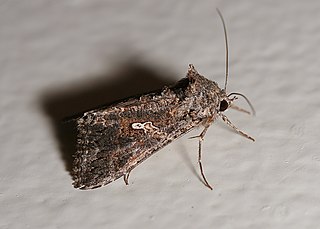
The cabbage looper is a medium-sized moth in the family Noctuidae, a family commonly referred to as owlet moths. Its common name comes from its preferred host plants and distinctive crawling behavior. Cruciferous vegetables, such as cabbage, bok choy, and broccoli, are its main host plant; hence, the reference to cabbage in its common name. The larva is called a looper because it arches its back into a loop when it crawls.

Papilio demodocus, the citrus swallowtail or Christmas butterfly, is a swallowtail butterfly which commonly occurs over the entirety of sub-Saharan Africa, including Madagascar, besides the southern Arabian Peninsula. The caterpillars feed on various native plants of especially the family Rutaceae, but have also taken to the leaves of cultivated citrus trees.

The diamondback moth, sometimes called the cabbage moth, is a moth species of the family Plutellidae and genus Plutella. The small, grayish-brown moth sometimes has a cream-colored band that forms a diamond along its back. The species may have originated in Europe, South Africa, or the Mediterranean region, but it has now spread worldwide.

Macrodactylus subspinosus is a North American beetle of the family Scarabaeidae. The members of this genus are known as "rose chafers", not to be confused with the European "rose chafer", Cetonia aurata. M. subspinosus occurs from Eastern Canada to Colorado and is considered a pest of many crops and flowers. It is given its common name of rose chafer because it eats the leaves of roses, although it also feeds on many other plants.

Agrotis ipsilon, the dark sword-grass, black cutworm, greasy cutworm, floodplain cutworm or ipsilon dart, is a small noctuid moth found worldwide. The moth gets its scientific name from black markings on its forewings shaped like the letter "Y" or the Greek letter upsilon. The larvae are known as "cutworms" because they cut plants and other crops. The larvae are serious agricultural pests and feed on nearly all varieties of vegetables and many important grains.

The harlequin cabbage bug, also known as calico bug, fire bug or harlequin bug, is a black stinkbug of the family Pentatomidae, brilliantly marked with red, orange, yellow and white markings. It is a major pest of cabbage and related crops in the Brassicaceae, as well as the ornamental flower cleome throughout tropical and North America, especially the warmer parts of the United States. Nymphs are active during the summer and in the tropics the bug can achieve three to six generations a year. In the northern range there is only one generation annually and the insects overwinter as adults in crop residues or field edges. Organic control involves hand-picking the insects off the plants and being especially careful to remove and destroy all the eggs, which are black-and-white striped, laid in clutches of twelve.

Spodoptera littoralis, also referred to as the African cotton leafworm or Egyptian cotton leafworm or Mediterranean brocade, is a species of moth in the family Noctuidae. S. littoralis is found widely in Africa, Mediterranean Europe and Middle Eastern countries. It is a highly polyphagous organism that is a pest of many cultivated plants and crops. As a result, this species was assigned the label of A2 quarantine pest by the EPPO and was cautioned as a highly invasive species in the United States. The devastating impacts caused by these pests have led to the development of both biological and chemical control methods. This moth is often confused with Spodoptera litura.
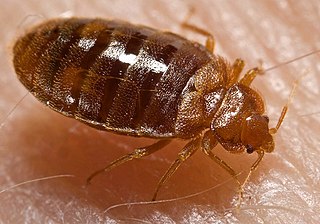
Cimex is a genus of insects in the family Cimicidae. Cimex species are ectoparasites that typically feed on the blood of birds and mammals. Two species, Cimex lectularius and Cimex hemipterus, are known as bed bugs and frequently feed on humans, although other species may parasitize humans opportunistically. Species that primarily parasitize bats are known as bat bugs.
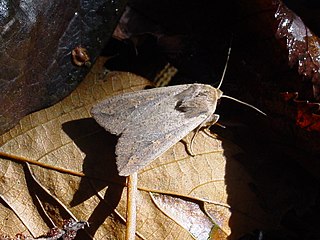
Mythimna unipuncta, the true armyworm moth, white-speck moth, common armyworm or rice armyworm, is a nocturnal agricultural pest belonging to the family Noctuidae. This moth is also commonly referred to by the scientific name Pseudaletia unipuncta. The species was first described by Adrian Hardy Haworth in 1809. Mythimna unipuncta is found in the Americas and in parts of Europe, Africa and Asia. Its original distribution is North and South America. It has been introduced to other places from there. They are known as armyworms because the caterpillars move in lines as a massive group, like an army, from field to field, damaging crops.
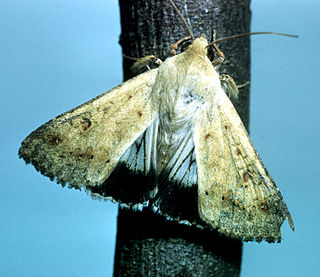
Helicoverpa punctigera, the native budworm, Australian bollworm or Chloridea marmada, is a species of moth in the family Noctuidae. This species is native to Australia. H. punctigera are capable of long distance migration from their inland Australian habitat towards coastal regions and are an occasional migrant to New Zealand.

Rhyzopertha is a monotypic genus of beetles in the family Bostrichidae, the false powderpost beetles. The sole species, Rhyzopertha dominica, is known commonly as the lesser grain borer, American wheat weevil, Australian wheat weevil, and stored grain borer. It is a beetle commonly found within store bought products and pest of stored cereal grains located worldwide. It is also a major pest of peanuts. The first documentation of wheat infestation by R. dominica was observed in Australia. R. dominica are usually reddish brown to dark brown in coloration, vary in sizes, elongated and cylindrical.

Cyclocephala borealis, the northern masked chafer, is a beetle in the family Scarabaeidae. It is native to North America, where it is considered a crop pest.
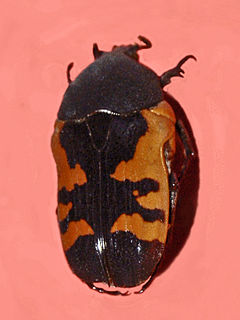
Polybaphes sanguinolenta is a species of fruit and flower chafers belonging to the family Scarabaeidae, subfamily Cetoniinae.

Pyronota festiva, commonly known as mānuka beetle or mānuka chafer, is a member of the genus Pyronota of the beetle family Scarabaeidae. It is a scarab beetle endemic to New Zealand, and is commonly found in mānuka trees, hence the beetle's name. In some areas it is considered a pasture pest.

Cyclocephala lurida, the southern masked chafer, is a species of beetle in the family Scarabaeidae which is native to the southeastern United States. It is a brown beetle with a black head, with an adult length of 10 to 14 mm. The adult beetles cause no harm, but the eggs are laid underground and the developing larvae feed on grass roots and can kill turf under dry conditions.
Frankliniella schultzei, the common blossom thrips or cotton thrips, is a species of thrips in the family Thripidae. It is found in many parts of the world and is an important pest insect in agriculture.
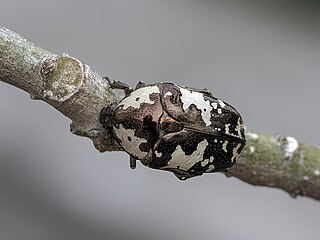
Protaetia aurichalcea is a species of flower-chafer beetle in the family Scarabaeidae. It is found in Asia.
Holotrichia serrata, commonly known as the sugarcane white grub, or cockchafer grub, is a species of dung beetle found in India, Bangladesh, and Sri Lanka.

















